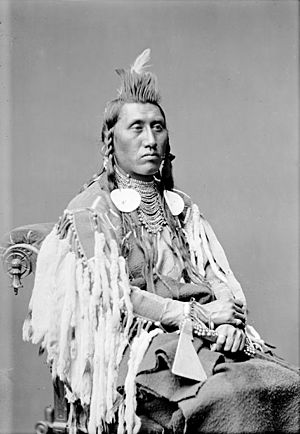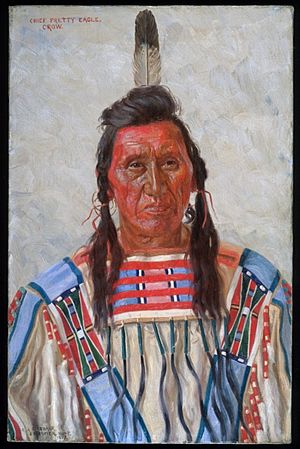Pretty Eagle facts for kids
Quick facts for kids
Pretty Eagle
|
|
|---|---|
| Déahĭtsĭśh | |

Chief Pretty Eagle, 1880.
|
|
| Born | 1846 Near Crow Agency, Montana
|
| Died | 11 November 1903 |
| Resting place | Pretty Eagle Point, Bighorn Canyon |
| Nationality | Crow |
| Known for | A chief of the Crow Indian Nation |
Chief Pretty Eagle (1846–1903) was an important leader of the Crow Nation, a Native American tribe. He was a skilled war chief, a brave warrior, and a clever diplomat. Born in 1846 near what is now Crow Agency, Montana, Pretty Eagle belonged to the Mountain Crow group. Throughout his life, he was known for his strength in battle and his deep care for his people. He often traveled to Washington, D.C., with other Crow leaders to discuss and protect the rights of his tribe, especially their land.
Contents
A Strong War Chief
Pretty Eagle was already a respected chief of the Crow people when the United States Army began exploring areas in Montana and Wyoming. These lands included the traditional territory of the Crow Nation. Pretty Eagle was a member of the Fox warrior society (I’axuxke) and the Piegan (Ackyā’mne) clan of the Crows. The Piegan clan was named after the Piegan Indian nation, who were part of the Blackfoot Confederacy and had been enemies of the Crow Nation for a long time.
As a warrior, Pretty Eagle was famous for his many brave actions against traditional Crow enemies. These included tribes like the Sioux and Pawnee. He performed enough specific war deeds, known as coups, to be recognized as a war chief by his people.
Working with the U.S. Government
Pretty Eagle, like many other Crow warriors, offered to serve as an Indian scout for the United States Army. Pretty Eagle and another famous chief, Plenty Coups, believed it was best to work with the U.S. government rather than fight against them.
The Crow people faced a difficult situation. Their traditional enemies, the Sioux, Cheyenne, and Arapaho nations, had formed new alliances. The Crow found themselves surrounded by enemies. They felt the U.S. Army could offer them protection and would also mean one less enemy to fight.
Pretty Eagle often joined other important Crow chiefs on their trips to Washington, D.C. They went to discuss important issues about Crow rights. In 1880, he was part of a Crow group that met with President Rutherford B. Hayes. They spoke out against selling Crow reservation lands. They also opposed the building of the Chicago, Burlington, and Quincy Railroads, which planned routes through the Crow Reservation.
Pretty Eagle supported new ways for his people to earn money. He encouraged grazing cattle and growing hay on Crow lands to sell to white farmers. This was important after the bison herds, a main food source, disappeared. Because of their cooperation, the Crow tribe was able to keep a large reservation on part of their ancestral land.
Death and Reburial
Pretty Eagle passed away on November 11, 1903. His remains were placed in a wagon box, which was different from the traditional scaffolds often used by the Crow. In the early 1900s, his remains, along with those of sixty other Crow people, were removed from their resting place along the Bighorn River. These remains were later sent to various museums across the U.S.
Returning Home: A Celebration
The remains of Pretty Eagle were finally returned to the Crow Nation 72 years after they were taken. This happened thanks to the hard work of Hugh White Clay and the Crow Cultural Commission. His remains were reburied on June 4, 1994, at Pretty Eagle Point. This special place, named in his honor, overlooks the Bighorn Canyon.
Horse-drawn travois, made from lodge poles and bison hide, were used to carry his remains to their current resting place. The date of the reburial has become a day of celebration for the Crow people. They often place offerings at the grave site to honor Chief Pretty Eagle.


